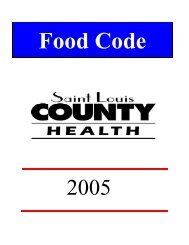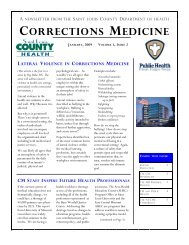Interim Guidelines for Expedited Partner Therapy - St. Louis County
Interim Guidelines for Expedited Partner Therapy - St. Louis County
Interim Guidelines for Expedited Partner Therapy - St. Louis County
Create successful ePaper yourself
Turn your PDF publications into a flip-book with our unique Google optimized e-Paper software.
August 2010<br />
<strong>St</strong>. <strong>Louis</strong> <strong>County</strong> Department of Health <strong>Interim</strong> Health <strong>Guidelines</strong> <strong>for</strong><br />
<strong>Expedited</strong> <strong>Partner</strong> Treatment (EPT) of Sexually Transmitted Diseases<br />
(STDs)<br />
On July 13, 2010, Governor Nixon signed HB 1375, amending RS MO 191 to allow <strong>for</strong><br />
<strong>Expedited</strong> <strong>Partner</strong> Treatment (EPT) <strong>for</strong> sexually transmitted diseases. The revision is<br />
effective on August 28, 2010. This legislation directs the Missouri Department of Health<br />
and Senior Services (MoDHSS) and the Division of Professional Registration within the<br />
Department of Insurance to develop by rule guidance <strong>for</strong> the implementation of EPT.<br />
MoDHSS does not anticipate completing this <strong>for</strong> about a year after the effective date. The<br />
<strong>St</strong>. <strong>Louis</strong> <strong>County</strong> Department of Health is providing this advisory guidance on an interim<br />
basis solely to assist local clinicians in providing EPT <strong>for</strong> appropriate patients and their<br />
partners.<br />
Summary <strong>Guidelines</strong><br />
• Patient’s diagnosis: clinical diagnosis of Chlamydia trachomatis or Neisseria gonorrhoeae<br />
• First‐choice partner management strategy: Attempt to bring partners in <strong>for</strong> complete clinical evaluation, STD<br />
testing, counseling, and treatment.<br />
• Most appropriate patients: those with partners who are unable or unlikely to seek timely clinical services<br />
• Recommended drug regimens (subject to change when CDC releases the 2010 STD Treatment <strong>Guidelines</strong><br />
o Patients diagnosed with chlamydia, but not gonorrhea:<br />
Azithromycin (Zithromax*) 1 gram (250 mg tablets x 4) orally once<br />
o Patients diagnosed with gonorrhea but not chlamydia:<br />
Cefixime (Suprax*) 400 mg orally once, OR cefpodoxime (Vantin*) 400 mg orally once or<br />
cefuroxime (Ceftin*) 1 gram orally once<br />
o Patients diagnosed with both gonorrhea and chlamydia:<br />
Cefixime (Suprax*) 400 mg orally once, OR cefpodoxime (Vantin*) 400 mg orally once or<br />
cefuroxime (Ceftin*) 1 gram orally once PLUS:<br />
Azithromycin (Zithromax*) 1 gram (250 mg tablets x 4) orally once<br />
• Number of doses is limited to the number of known sex partners in previous 60 days (or most recent sex<br />
partner if none in the previous 60 days).<br />
• In<strong>for</strong>mational materials should accompany medication and include clear instructions, warnings, and<br />
referrals.(see attached)<br />
• Patient counseling: abstinence until seven days after treatment and until seven days after partners have<br />
been treated<br />
• Patient re‐testing <strong>for</strong> gonorrhea and chlamydia is recommended <strong>for</strong> three months after treatment.<br />
• Adverse reactions: Missouri’s EPT legislation protects physicians providing EPT from civil liability, except when<br />
the physician “acts negligently, recklessly, in bad faith, or with malicious purpose”. To report adverse<br />
reactions, email EPT@dhss.mo.gov or call 573‐751‐6439.<br />
* Use of trade names is <strong>for</strong> identification only and does not imply endorsement.<br />
<strong>Interim</strong> Guidance <strong>for</strong> EPT Page 1
Background:<br />
<strong>Expedited</strong> <strong>Partner</strong> Treatment (EPT) is a process of providing empiric antibiotics to the sex partners of patients<br />
with certain sexually transmitted diseases, even though the treating provider may not have an established<br />
therapeutic relationship with the partners. EPT treats unrecognized or undetected infection in the partners,<br />
and serves to prevent re‐infection of the index patient (the index patient is the patient you have identified<br />
with gonorrhea or chlamydia in your clinical care). Research studies have shown that heterosexual patients<br />
with uncomplicated gonorrhea or chlamydia have lower rates of re‐infection when their sex partners are<br />
provided with EPT, and this approach is now supported by the federal Centers <strong>for</strong> Disease Control and<br />
Prevention (CDC).<br />
A complete review of the studies and recommendations were published in 2006 by the CDC in “<strong>Expedited</strong><br />
<strong>Partner</strong> <strong>Therapy</strong> in the Management of Sexually Transmitted Diseases: Review and Guidance.” The report is<br />
available online: http://www.cdc.gov/std/treatment/EPTFinalReport2006.pdf.<br />
<strong>Expedited</strong> <strong>Partner</strong> Treatment <strong>Guidelines</strong>:<br />
These guidelines have been developed to assist clinicians in deciding when to offer EPT, and to outline<br />
procedures to follow when choosing this option.<br />
EPT Eligible Patients: Persons with a clinical diagnosis of Chlamydia trachomatis or Neisseria gonorrhoeae,<br />
preferably confirmed with a laboratory test.<br />
EPT Eligible <strong>Partner</strong>s: Sex partners of patients treated <strong>for</strong> chlamydia and/or gonorrhea who were exposed<br />
within the previous 60 days (or most recent sex partner if none in the previous 60 days), and who are unable<br />
or unlikely to seek medical care. (See page 3 <strong>for</strong> additional recommendations).<br />
The <strong>St</strong>. <strong>Louis</strong> <strong>County</strong> Department of Health will revise this interim EPT guidance after the CDC releases its 2010<br />
STD Treatment <strong>Guidelines</strong>.<br />
General Principles:<br />
The best approach is <strong>for</strong> the partner(s) of a patient diagnosed with any STD to be evaluated, examined, tested,<br />
counseled, and treated by a medical provider. Clinicians should counsel index patients who are diagnosed<br />
with an STD to have their sexual partner(s) evaluated by their own primary care provider or at a public health<br />
clinic, and not to resume sexual intercourse with that partner until the partner has been adequately treated.<br />
Ideally, clinicians will provide in<strong>for</strong>mation to every patient with an STD regarding their diagnosis, the<br />
treatment provided, and where their partner may obtain medical care. (Referral <strong>for</strong>ms are available from<br />
the <strong>St</strong>. <strong>Louis</strong> <strong>County</strong> STD Program).<br />
As standard practice, clinicians should encourage patients diagnosed with chlamydia or gonorrhea to notify all<br />
of the people with whom they have had sexual contact within the two months prior to diagnosis or onset of<br />
<strong>Interim</strong> Guidance <strong>for</strong> EPT Page 2
symptoms. Ideally, the partner(s) should be in<strong>for</strong>med about the specific infection that they have been exposed<br />
to, and offered a written referral. Clinicians may offer index patients EPT if the patient believes that their<br />
partner(s) will refuse to seek or will not be able to obtain medical care.<br />
Medication <strong>for</strong> EPT should be provided <strong>for</strong> all sexual partners within two months prior to the index patient’s<br />
diagnosis or onset of symptoms. If the index patient has not had any partners in the prior two months, then<br />
the most recent sexual partner should be treated. Medications should not be provided to treat other sexual<br />
partners of partners to the index patient.<br />
Public Health Importance of Chlamydia and Gonorrhea<br />
Sexually transmitted chlamydia and gonorrhea infections are significant public health problems. More than<br />
5,000 cases of chlamydia and 1,300 cases of gonorrhea were reported in <strong>St</strong>. <strong>Louis</strong> <strong>County</strong> during 2009 [1],<br />
making them two of the three most common reportable communicable infections. Genital tract infections<br />
can lead to pelvic inflammatory disease (PID), chronic pelvic pain, ectopic pregnancy, and preventable<br />
infertility in women [2]. Patients with these infections are also at increased risk of acquiring sexually<br />
transmitted HIV [3]. Repeat gonorrhea infections, which increase the risk of complications, occur in up to 11<br />
percent of women and men within six months after treatment [4, 5]. Repeat chlamydia infections occur in<br />
up to 13 percent of patients in this same time period [6]. To prevent repeat infections, reduce complications<br />
in individuals, and reduce further transmission of infection in the community, sex partners of infected patients<br />
must be provided timely and appropriate antibiotic treatment.<br />
Barriers to Effective <strong>Partner</strong> Management<br />
Currently, there are considerable challenges to effective partner management. Public health ef<strong>for</strong>ts to notify<br />
and treat sex partners have proven successful and are considered a cornerstone of syphilis control [7].<br />
However, because of the high burden of infection and limited public health resources <strong>for</strong> partner notification<br />
activities, it is difficult <strong>for</strong> local health departments to provide investigation and partner notification <strong>for</strong> cases<br />
of gonorrhea and chlamydia [8]. Most local health departments in the <strong>St</strong>. <strong>Louis</strong> area do not routinely<br />
provide partner management services <strong>for</strong> uncomplicated chlamydia and gonorrhea cases. Thus, the<br />
standard of care <strong>for</strong> partner management <strong>for</strong> chlamydia and gonorrhea cases has become patient referral,<br />
whereby health care providers counsel patients about the need <strong>for</strong> partner treatment and that the<br />
responsibility <strong>for</strong> notifying partners rests with the patient.<br />
The effectiveness of patient referral is limited by the patient’s choice in notifying the partner, as well as the<br />
partner’s choice in seeking treatment. Asymptomatic partners often fail to seek care because they have no<br />
signs or symptoms of infection, and they incorrectly assume they are not infected. Additionally, some<br />
partners may be uninsured and have limited access to medical care. These limitations to the effectiveness of<br />
partner referral demonstrate the need <strong>for</strong> additional strategies to ensure sex partner treatment such as<br />
expedited partner therapy.<br />
Considerations in Using EPT<br />
There are several concerns about EPT.<br />
First, the medication could theoretically cause a serious adverse<br />
<strong>Interim</strong> Guidance <strong>for</strong> EPT Page 3
eaction, including allergy. However, adverse reactions to recommended EPT medications, beyond mild side<br />
effects, are rare. Second, EPT may compromise the quality of care provided to sex partners, particularly if it<br />
is used as a first‐line approach <strong>for</strong> partners who would otherwise seek clinical services. Appropriate care <strong>for</strong><br />
sex partners to persons with chlamydia and gonorrhea infections includes testing <strong>for</strong> other STDs and HIV,<br />
physical examination to rule out a complicated infection, and risk‐reduction counseling. Ideally, partners<br />
who receive EPT will still access these clinical services. Despite these concerns, the benefits of EPT outweigh<br />
the risks, since doing nothing <strong>for</strong> these partners is more harmful. Further, these risks may be mitigated<br />
through patient education and written materials <strong>for</strong> partners that provide warnings and encourage visiting a<br />
health care provider.<br />
Additional concerns about EPT include potential misuse of the medication, waste if the medication is not<br />
delivered or not taken, and contribution to antibiotic resistance at the population level. Currently, there is<br />
no evidence that EPT is misused or leads to increasing antimicrobial resistance.<br />
Selecting Appropriate Patients <strong>for</strong> EPT<br />
Appropriate patients are those with a clinical diagnosis of sexually transmitted chlamydia or gonorrhea<br />
infection, preferably with laboratory confirmation. Laboratory confirmation of the diagnosis may include a<br />
gram stain of male urethral exudate showing gram negative intracellular diplococci indicative of gonorrhea; a<br />
positive culture test <strong>for</strong> chlamydia or gonorrhea; or a positive nucleic acid amplification test (NAAT) <strong>for</strong><br />
chlamydia or gonorrhea (e.g., GenProbe Aptima, Becton Dickinson ProbeTec, Roche polymerase chain<br />
reaction (PCR) Amplicor). Because of their high sensitivity, NAATs are the tests of choice <strong>for</strong> chlamydia and<br />
gonorrhea screening and testing.<br />
Providing EPT without laboratory confirmation should only be considered when the provider has a high clinical<br />
suspicion <strong>for</strong> chlamydia or gonorrhea infection in the index case and there is concern about loss of follow‐up.<br />
Clinicians should attempt to motivate patients to refer their partners <strong>for</strong> comprehensive health care, including<br />
evaluation, testing and treatment. Clinical services provide the opportunity to ensure treatment; confirm the<br />
diagnosis; examine the patient; test <strong>for</strong> other STDs, HIV and pregnancy; provide needed vaccinations; and<br />
offer risk‐reduction counseling and community referrals. These services constitute the standard of care <strong>for</strong><br />
all partners of patients infected with a sexually transmitted infection.<br />
Thus, patients most appropriate <strong>for</strong> EPT are those with partners who are unable or unlikely to seek prompt<br />
clinical services. Factors to consider in the patient’s report are that the partner is uninsured, lacks a primary<br />
care provider, faces significant barriers to accessing clinical services, or will be unwilling to seek care.<br />
Providers also should assess the acceptability of EPT to both the patient and the partners receiving it. Even if<br />
EPT is provided, the partner should still be encouraged to seek follow‐up care as soon as possible.<br />
Providers should assess the partner’s symptom status, particularly symptoms indicative of a complicated<br />
infection; pregnancy status; and risk <strong>for</strong> severe medication allergies. If the partner is pregnant, every ef<strong>for</strong>t<br />
should be made to contact her <strong>for</strong> referral to pregnancy services and/or prenatal care. The local health<br />
department may be of assistance in notifying and referring pregnant partners <strong>for</strong> these special situations.<br />
For partners with known severe allergies to antibiotics, EPT should not be used.<br />
<strong>Interim</strong> Guidance <strong>for</strong> EPT Page 4
Missouri law permits EPT regardless of the patient’s gender or sexual orientation. Further, EPT is not<br />
appropriate <strong>for</strong> patients co‐infected with STDs not covered by EPT medication; cases of suspected child abuse<br />
or sexual assault; or a situation in which the patient’s safety is in doubt.<br />
Liability<br />
Missouri’s EPT legislation protects physicians providing EPT from civil liability, except when the physician “acts<br />
negligently, recklessly, in bad faith, or with malicious purpose”. There is nothing in the Missouri EPT<br />
legislation that requires physicians to provide EPT [10].<br />
Limitations of EPT<br />
The use of EPT to treat certain partners [e.g., females, and men who have sex with men (MSM)] may increase<br />
the risk of under‐treating a complicated infection or missing a concurrent STD/HIV infection in the partner.<br />
Clinicians do have the option of providing EPT <strong>for</strong> female partners of patients with chlamydia or gonorrhea<br />
infections. Clinicians should in<strong>for</strong>m heterosexual male patients with gonorrhea or chlamydia that it is best <strong>for</strong><br />
their female partners to have a medical evaluation, but if they feel that their partner is unwilling or unable to<br />
seek care, then EPT may be provided unless the partner is known to be pregnant. Although the medications<br />
used <strong>for</strong> EPT are safe in pregnancy, EPT should not generally be provided to pregnant partners. Refer<br />
pregnant women to their prenatal care provider or to another appropriate medical provider.<br />
Currently, there is insufficient evidence to demonstrate the effectiveness of EPT <strong>for</strong> men who have sex with<br />
men (MSM). Ideally, MSM who are contacts to gonorrhea or chlamydia should be examined and tested <strong>for</strong><br />
other STDs, such as syphilis and HIV. HIV rates are higher among MSM than the general population [9].<br />
There<strong>for</strong>e, male partners of MSM should be encouraged to seek medical evaluation whenever possible.<br />
Clinicians will need to carefully weigh these limitations when making decisions about providing EPT.<br />
Making Contact with <strong>Partner</strong>s and Documentation<br />
A note in the index patient’s medical chart should document the number of partners who are being provided<br />
with EPT, the medication and dosage being provided, and whether the partner is known to be allergic to any<br />
medications.<br />
Whenever possible, telephone contact should be made with the sexual partner(s) to explain the reason <strong>for</strong><br />
providing EPT, to ask about allergies to medications, medical problems, medications being taken, to ask about<br />
other symptoms of STDs (such as whether there are sores, ulcers, discharge, testicular, or abdominal pains<br />
that need medical evaluation), and to answer questions. Female partners <strong>for</strong> EPT should be asked if they are<br />
pregnant or breastfeeding, and if they have any symptoms such as abdominal pain that will require immediate<br />
medical evaluation. <strong>Partner</strong>s should be advised to abstain from intercourse <strong>for</strong> seven days after taking the<br />
medication.<br />
Gonorrhea and chlamydia are reportable diseases. Clinicians are required to report infections to the Missouri<br />
<strong>Interim</strong> Guidance <strong>for</strong> EPT Page 5
Department of Health and Senior Services or the local health agency. Reporting <strong>for</strong>ms are available on the<br />
MoDHSS website (www.dhss.mo.gov/CommunicableDisease/CD‐1.dot). The index patient and their named<br />
partners will probably not be contacted by MoDHSS or local health department staff unless certain<br />
circumstances exist (e.g. co‐infection with HIV or early syphilis, pregnant females, or those with repeat<br />
infections). Please contact the MoDHSS or local health agency STD Program <strong>for</strong> further in<strong>for</strong>mation (see<br />
Appendix 1).<br />
Recommended Treatments <strong>for</strong> Persons Exposed to Chlamydia or Gonorrhea<br />
Missouri’s EPT legislation requires that any antibiotic used <strong>for</strong> EPT be in pill <strong>for</strong>m. The legislation allows<br />
physicians to “prescribe and dispense medications <strong>for</strong> the treatment of chlamydia or gonorrhea” <strong>for</strong> persons<br />
who are partners to patients with chlamydia or gonorrhea.<br />
1. Medication may be provided to the index patient to take to his or her partner(s.)<br />
2. Separate prescriptions may be written <strong>for</strong> the index patient and his or her partner(s).<br />
As a matter of policy, the <strong>St</strong>. <strong>Louis</strong> <strong>County</strong> Department of Health recommends that clinicians adhere to CDC’s<br />
updated 2006 STD Treatment <strong>Guidelines</strong> <strong>for</strong> treating partners to chlamydia and gonorrhea. This document is<br />
available at http://www.cdc.gov/std/treatment/2006/updated‐regimens.htm. These guidelines call <strong>for</strong> the<br />
following regimens:<br />
For chlamydial infection<br />
<strong>Partner</strong>s of patients with chlamydial infection should be treated with azithromycin 1 gram orally in a single<br />
dose. If the partner is allergic to macrolide antibiotics, consult the STD Treatment <strong>Guidelines</strong>, 2006 (see<br />
above) or contact a physician specializing in infectious disease or STD treatment <strong>for</strong> further instructions.<br />
For gonorrhea<br />
<strong>Partner</strong>s of patients with uncomplicated gonorrhea should be treated with cefixime (Suprax*) 400 mg orally<br />
in a single dose or cefpodoxime (Vantin*) 400mg in a single dose, or cefuroxime (Ceftin*) 1 gram orally in a<br />
single dose.<br />
Please Note: Quinolone antibiotics (i.e. ciprofloxacin, levofloxacin, ofloxacin) are no longer<br />
recommended <strong>for</strong> the treatment of gonorrhea in the United <strong>St</strong>ates, as reported in the MMWR,<br />
April 13, 2007. Suspected pharyngeal gonorrhea should not be treated with oral<br />
cephalosporin antibiotics. Updated gonorrhea treatment regimens can be found online at:<br />
http://www.cdc.gov/std/treatment/2006/updated‐regimens.htm<br />
<strong>Partner</strong>s of patients with gonorrhea should be co‐treated <strong>for</strong> chlamydia unless the index case has a negative<br />
chlamydia test result using a nucleic acid amplification test (NAAT) technology. Use azithromycin 1‐gram PO to<br />
co‐treat <strong>for</strong> chlamydia. (This recommendation is subject to change with the release of the 2010 STD<br />
Treatment <strong>Guidelines</strong>.) It is not recommended that patients with chlamydia be co‐treated <strong>for</strong> gonorrhea.<br />
<strong>Interim</strong> Guidance <strong>for</strong> EPT Page 6
* Use of trade names is <strong>for</strong> identification only and does not imply endorsement.<br />
Other STDs:<br />
These guidelines only address providing EPT <strong>for</strong> partners of persons with chlamydia and gonorrhea.<br />
Missouri’s EPT legislation does not cover other STDs. Except <strong>for</strong> trichomoniasis, there is limited evidence to<br />
support this intervention with any other STDs at this time. For further in<strong>for</strong>mation on treatment of STDs refer<br />
to: STD Treatment <strong>Guidelines</strong>, 2006 Centers <strong>for</strong> Disease Control and Prevention (CDC) MMWR 2006; 55 (No.<br />
RR‐11, available online at : http://www.cdc.gov/std/treatment/<br />
In<strong>for</strong>mation <strong>for</strong> Patients<br />
Missouri’s EPT legislation requires that physicians who utilize EPT provide guidance to index patients<br />
diagnosed with chlamydia or gonorrhea with “in<strong>for</strong>mation designed to stop the spread of such diagnosis” [10].<br />
The <strong>St</strong>. <strong>Louis</strong> <strong>County</strong> Department of Health has created both chlamydia and gonorrhea fact sheets that contain<br />
this in<strong>for</strong>mation (Appendices 2 and 3). In addition, the department has created in<strong>for</strong>mation sheets that index<br />
cases with chlamydia or gonorrhea can give to their partners (Appendices 4 and 5).<br />
The CDC does not recommend tests‐of‐cure <strong>for</strong> patients who are treated <strong>for</strong> gonorrhea or chlamydia, nor are<br />
they recommended <strong>for</strong> the sexual partners who receive EPT. However, because of high rates of re‐infection,<br />
the CDC recommends that patients treated <strong>for</strong> gonorrhea and all women with chlamydia be re‐tested three<br />
months after treatment. If the patient is not re‐tested in three months, providers are encouraged to test<br />
whenever the patient next seeks medical care within the following 3‐12 months, regardless of whether the<br />
patient believes that his or her sex partners were treated.<br />
Consultations<br />
For questions about EPT contact the <strong>St</strong>. <strong>Louis</strong> <strong>County</strong> Department of Health’s STD Program at 314‐615‐8331<br />
Reporting Adverse Events:<br />
Report any adverse events that result from EPT to the Missouri Department of Health and Senior Services at<br />
573‐751‐6439, or through email at EPT@dhss.mo.gov.<br />
References Cited<br />
1. <strong>St</strong>. <strong>Louis</strong> <strong>County</strong> Department of Health, Communicable Disease Control Services.<br />
2. Hook, E.W, Handsfield, H.H. Gonococcal infections in the adult. In: Holmes, K.K.; Sparling, P.F.;<br />
Mardh, P‐A, et al., eds. Sexually Transmitted Diseases, 3rd Edition. New York, NY: McGraw‐Hill,<br />
1999:451‐466.<br />
3. Wasserheit, J.N. Epidemiological synergy. Interrelationships between human immunodeficiency virus<br />
infection and other sexually transmitted diseases. Sex Transm Dis 1992;19:61‐77.<br />
4. Mehta, S.D., Erbelding, E.J.; Zenilman, J.M. and Rompalo, A.M. Gonorrhoea reinfection in<br />
<strong>Interim</strong> Guidance <strong>for</strong> EPT Page 7
heterosexual STD clinic attendees: longitudinal analysis of risks <strong>for</strong> first reinfection. Sex Transm Infect<br />
2003;79:124‐8.<br />
5. Peterman, T.A.;Tian, L.H.; Metcalf, C.A., et al. High incidence of new sexually transmitted infections in<br />
the year following a sexually transmitted infection: A case <strong>for</strong> rescreening. Ann Intern Med<br />
2006;145:564‐72.<br />
6. Whittington, W.L.; Kent, C.; Kissinger, P., et al. Determinants of persistent and recurrent Chlamydia<br />
trachomatis infection in young women: Results of a multicenter cohort study. Sex Transm Dis<br />
2001;28:117‐123.<br />
7. Oxman, A.D.; Scott, E.A.; Sellors, J.W., et al. <strong>Partner</strong> notification <strong>for</strong> sexually transmitted diseases: an<br />
overview of the evidence. Can J Public Health 1994;85 Suppl 1:S41‐7.<br />
8. Golden, M.R.; Hogben, M,; Handsfield, H.H.; <strong>St</strong>. Lawrence, J.S.; Potterat, J.J. and Holmes, K.K. <strong>Partner</strong><br />
notification <strong>for</strong> HIV and STD in the United <strong>St</strong>ates: low coverage <strong>for</strong> gonorrhea, chlamydial infection,<br />
and HIV. Sex Transm Dis 2003;30:490‐496.<br />
9. CDC. Subpopulation Estimates from the HIV Incidence Surveillance System – United <strong>St</strong>ates, 2006.<br />
MMWR 2008;57: 985‐989.C<br />
10. Senate Committee Substitute <strong>for</strong> House Committee Substitute <strong>for</strong> House Bill 1375, Second Regular<br />
Session, 95 th General Assembly, Truly Agreed and Finally Passed, Missouri General Assembly.<br />
<strong>Interim</strong> Guidance <strong>for</strong> EPT Page 8
Appendix 1<br />
Contact In<strong>for</strong>mation <strong>for</strong> <strong>St</strong>. <strong>Louis</strong> Area STD Programs<br />
<strong>St</strong>. <strong>Louis</strong> <strong>County</strong> Department of Health: 314‐615‐8331. Fax: 314‐615‐8346<br />
<strong>St</strong>. <strong>Louis</strong> City Health Department: 314‐657‐1551. Fax: 314‐612‐6267<br />
Missouri Department of Health and Senior Services, Eastern District Office: Phone: 314‐877‐2814<br />
Fax: 314‐877‐2807
Appendix 2<br />
IMPORTANT INFORMATION ABOUT YOUR HEALTH<br />
FACT SHEET ABOUT CHLAMYDIA AND PREVENTING SEXUALLY<br />
TRANSMITTED DISEASES (STD)<br />
You have been diagnosed and treated <strong>for</strong> chlamydia. Chlamydia is a curable sexually transmitted disease<br />
(STD) that can be spread from an infected partner through vaginal, oral, or anal sex. Most people with this STD<br />
have no signs or symptoms nor do they feel ill. Even so, they may continue to infect others if not properly<br />
treated. If symptoms are present they may include:<br />
-Men might notice a discharge (drip) from their penis, pain or discom<strong>for</strong>t when urinating (peeing), pain or<br />
itching around the opening of the penis, or pain and swelling in the testicles.<br />
-Women might notice a change in their usual vaginal discharge, pain during sex, bleeding between<br />
periods or after sex, lower belly or pelvic cramps or pain, or pain when urinating (peeing). Women can<br />
become infertile (unable to have children) if they don’t receive treatment <strong>for</strong> this infection.<br />
Even if symptoms are present they may go away on their own without medication. However, that does not<br />
mean the STD has gone away. Without proper medication the untreated infection can cause serious<br />
complications in your body as well as continue to be spread to others.<br />
You can reduce your risk of acquiring another STD by:<br />
Making sure your sex partner gets treated <strong>for</strong> chlamydia<br />
And<br />
Do not have sex <strong>for</strong> the next seven days after you (and your partner) have taken the medication. It takes<br />
seven days <strong>for</strong> the medicine to cure the infection. During those first seven days, you can still pass on the<br />
infection to your sex partners and/or your partner could re-infect you.<br />
Being abstinent (not having sex)<br />
Using condoms correctly every time you have sex<br />
Having only one sex partner who is only having sex with you<br />
If you have multiple partners, reducing the number of partners you have<br />
Being tested on a regular basis <strong>for</strong> HIV and STDs<br />
If you would like to refer your partner <strong>for</strong> free STD testing and treatment, please see the in<strong>for</strong>mation below:<br />
North Central Community Health Center, Specialty Clinic The SPOT<br />
4000 Jennings <strong>St</strong>ation Road, Pine Lawn, MO 63121. 4169 Laclede, 1 st Floor, <strong>St</strong>. <strong>Louis</strong>, MO 63108<br />
STD services are offered on a walk-in basis only, patient limits may<br />
apply.<br />
Specialty Clinic hours of operation are as follows:<br />
Services at the SPOT are <strong>for</strong> 13-24 year olds only<br />
Monday, Tuesday, Wednesday, and Friday:<br />
8:00am-11:15am & 12:30pm-3:30 pm<br />
Walk-in STD services are offered Monday-Friday,<br />
1pm-5pm<br />
Thursday, 9:00am-12:15pm & 1:30pm-4:30pm<br />
**The first Thursday of each month Clinic hours are 1pm- 4pm<br />
For more in<strong>for</strong>mation please call (314) 679-7800. For more in<strong>for</strong>mation, please call (314) 535-0413<br />
August, 2010
Appendix 3<br />
IMPORTANT INFORMATION ABOUT YOUR HEALTH<br />
FACT SHEET ABOUT GONORRHEA AND PREVENTING SEXUALLY<br />
TRANSMITTED DISEASES (STD)<br />
You have been diagnosed and treated <strong>for</strong> gonorrhea. Gonorrhea is a curable sexually transmitted disease<br />
(STD) that can be spread from an infected partner through vaginal, oral, or anal sex. Many people with STD<br />
have no signs or symptoms nor do they feel ill. Even so, they may continue to infect others if not properly<br />
treated. If symptoms are present they may include:<br />
-Men might notice a yellow or greenish discharge (drip) from their penis, pain or discom<strong>for</strong>t when<br />
urinating (peeing), or pain and swelling in their testicles.<br />
-Women might notice a change in their usual vaginal discharge, pain during sex, bleeding between<br />
periods or after sex, lower belly or pelvic cramps or pain, or pain when urinating (peeing). Women can<br />
become infertile (unable to have children) if they don’t receive treatment <strong>for</strong> this infection.<br />
Even if symptoms are present they may go away on their own without medication. However, that does not<br />
mean the STD has gone away. Without proper medication the untreated infection can cause serious<br />
complications in your body as well as continue to be spread to others.<br />
If you are treated, but your partner is not you are at risk of getting re-infected. It is important that all sex partners<br />
receive adequate testing and treatment in order to stop the spread of infection(s).<br />
You can reduce your risk of acquiring another STD by:<br />
Making sure your sex partner gets treated <strong>for</strong> gonorrhea<br />
And<br />
Do not have sex <strong>for</strong> the next seven days after you (and your partner) have taken the medication. It takes<br />
seven days <strong>for</strong> the medicine to cure the infection. During those first seven days, you can still pass on the<br />
infection to your sex partners and/or your partner could re-infect you.<br />
Being abstinent (not having sex)<br />
Using condoms correctly every time you have sex<br />
Having only one sex partner who is only having sex with you<br />
If you have multiple partners, reducing the number of partners you have<br />
Being tested on a regular basis <strong>for</strong> HIV and STDs<br />
If you would like to refer your partner <strong>for</strong> free STD testing and treatment, please see the in<strong>for</strong>mation below:<br />
North Central Community Health Center, Specialty Clinic The SPOT<br />
4000 Jennings <strong>St</strong>ation Road, Pine Lawn, MO 63121. 4169 Laclede, 1 st Floor, <strong>St</strong>. <strong>Louis</strong>, MO 63108<br />
The clinic is operated on a walk-in basis, patient limits may apply.<br />
Specialty Clinic hours of operation are as follows:<br />
Services at the SPOT are <strong>for</strong> 13-24 year olds only<br />
Monday, Tuesday, Wednesday, and Friday:<br />
8:00am-11:15am & 12:30pm-3:30 pm<br />
Walk-in STD services are offered Monday-Friday,<br />
1pm-5pm<br />
Thursday, 9:00am-12:15pm & 1:30pm-4:30pm<br />
**The first Thursday of each month Clinic hours are 1pm- 4pm<br />
For more in<strong>for</strong>mation please call (314) 679-7800. For more in<strong>for</strong>mation, please call (314) 535-0413<br />
August, 2010
IMPORTANT INFORMATION ABOUT YOUR HEALTH<br />
FACT SHEET ABOUT CHLAMYDIA and PARTNER TREATMENT<br />
You are being treated as a contact to a sex partner who was diagnosed with chlamydia. Chlamydia is a curable sexually<br />
transmitted disease (STD) that can be spread from an infected partner through vaginal, oral, or anal sex. Chlamydia is a<br />
very common infection, and most people with this STD have no signs or symptoms nor do they feel ill. If symptoms are<br />
present they may include:<br />
-Men might notice a discharge (drip) from their penis, pain or discom<strong>for</strong>t when urinating (peeing), pain or itching<br />
around the opening of the penis, or pain and swelling in the testicles.<br />
-Women might notice a change in their usual vaginal discharge, pain during sex, bleeding between periods or after<br />
sex, lower belly or pelvic cramps or pain, or pain when urinating (peeing). Women can become infertile (unable to<br />
have children) if they don’t receive treatment <strong>for</strong> this infection.<br />
Even if symptoms are present they may go away on their own without medication. However, that does not mean the STD<br />
has gone away. Without proper medication the untreated infection can cause serious complications in your body as well as<br />
continue to be spread to others.<br />
Be<strong>for</strong>e you take the medicine, please read the following:<br />
Azithromycin is very safe antibiotic. However, DO NOT TAKE IT if any of the following are true:<br />
• You are female and having lower belly pain, pain during sex, vomiting, or fever.<br />
• You are pregnant.<br />
• You are male and having pain or swelling in the testicles (balls) with or without fever.<br />
• Have ever had a bad reaction, hives (a kind of rash), or allergy to any other antibiotics.<br />
• Have a serious long-term illness like kidney, heart or liver disease.<br />
If any of these circumstances exist, you should talk to your healthcare provider as soon as possible.<br />
Some people may get a mild upset stomach or diarrhea after taking azithromycin. If you experience any other side effects, or<br />
an allergic reaction (rash, itching, swelling, dizziness, or trouble breathing), call your healthcare provider immediately.<br />
Take the entire prescription of azithromycin (1000mg) all at once with a full glass of water. Taking it with food may<br />
reduce stomach upset. It is important that you take this medicine as soon as possible to get cured.<br />
*Do not share or give this medicine to anyone else.<br />
*Do not have sex <strong>for</strong> the next 7 days. It takes 7 days <strong>for</strong> the medicine to cure chlamydia. You can still spread the infection<br />
during this time.<br />
If you would like to refer your partner <strong>for</strong> free STD testing and treatment, please see the testing sites listed below:<br />
North Central Community Health Center, Specialty Clinic The SPOT<br />
4000 Jennings <strong>St</strong>ation Road, Pine Lawn, MO 63121. 4169 Laclede, 1 st Floor, <strong>St</strong>. <strong>Louis</strong>, MO 63108<br />
STD services are offered on a walk-in basis only, patient limits may<br />
apply.<br />
Specialty Clinic hours of operation are as follows:<br />
Services at the SPOT are <strong>for</strong> 13-24 year olds only<br />
Monday, Tuesday, Wednesday, and Friday:<br />
8:00am-11:15am & 12:30pm-3:30 pm<br />
Walk-in STD services are offered Monday-Friday,<br />
1pm-5pm<br />
Thursday, 9:00am-12:15pm & 1:30pm-4:30pm<br />
**The first Thursday of each month Clinic hours are 1pm- 4pm<br />
For more in<strong>for</strong>mation please call (314) 679-7800. For more in<strong>for</strong>mation, please call (314) 535-0413<br />
August, 2010<br />
Appendix 4
Appendix 5<br />
IMPORTANT INFORMATION ABOUT YOUR HEALTH<br />
FACT SHEET ABOUT GONORRHEA and PARTNER TREATMENT<br />
You are being treated as a contact to a sex partner who was diagnosed with gonorrhea. Gonorrhea is a curable sexually<br />
transmitted disease (STD) that can be spread from an infected partner through vaginal, oral, or anal sex. Many people with<br />
gonorrhea have no signs or symptoms nor do they feel ill. If symptoms are present they may include:<br />
-Men might notice a white, green or yellow discharge (drip) from their penis, and/or painful urination (peeing).<br />
-Women might notice a change in their vaginal discharge, pain in their lower belly, pain during sex, or vaginal<br />
bleeding between periods.<br />
Even if symptoms are present they may go away on their own without medication. However, that does not mean the STD<br />
has gone away. Without proper medication the untreated infection can cause serious complications in your body as well as<br />
continue to be spread to others.<br />
Be<strong>for</strong>e you take the medicine, please read the following:<br />
Cefixime (Suprax), cefpodoxime (Vantin) and cefuroxime (Ceftin), are very safe treatments <strong>for</strong> gonorrhea. However, DO<br />
NOT TAKE IT if any of the following are true:<br />
• You are female and having lower belly pain, pain during sex, vomiting, or fever.<br />
• You are male and having pain or swelling in the testicles (balls) with or without fever.<br />
• Have a rash all over your body.<br />
• Have ever had a bad reaction, hives (a kind of rash), or allergy to any other antibiotics.<br />
• Have a serious long-term illness like kidney, heart or liver disease.<br />
If any of these circumstances exist, you should talk to your healthcare provider as soon as possible in order to<br />
find the best treatment <strong>for</strong> you.<br />
Some people may get a mild upset stomach, diarrhea or vaginal yeast infection after taking this medication. If you<br />
experience any other symptoms, or an allergic reaction (rash, itching, swelling, dizziness, or trouble breathing), call your<br />
healthcare provider immediately.<br />
Take the medication your partner is providing you with a full glass of water. It is important that you take this<br />
medicine as soon as possible to get cured.<br />
*Do not share or give this medicine to anyone else.<br />
*Do not have sex <strong>for</strong> the next 7 days. It takes 7 days <strong>for</strong> the medicine to cure gonorrhea. You can still spread the infection<br />
during this time.<br />
If you would like to refer your partner <strong>for</strong> free STD testing and treatment, please see the in<strong>for</strong>mation below:<br />
North Central Community Health Center, Specialty Clinic The SPOT<br />
4000 Jennings <strong>St</strong>ation Road, Pine Lawn, MO 63121. 4169 Laclede, 1 st Floor, <strong>St</strong>. <strong>Louis</strong>, MO 63108<br />
STD services are offered on a walk-in basis only, patient limits may<br />
apply.<br />
Specialty Clinic hours of operation are as follows:<br />
Services at the SPOT are <strong>for</strong> 13-24 year olds only<br />
Monday, Tuesday, Wednesday, and Friday:<br />
8:00am-11:15am & 12:30pm-3:30 pm<br />
Walk-in STD services are offered Monday-Friday,<br />
1pm-5pm<br />
Thursday, 9:00am-12:15pm & 1:30pm-4:30pm<br />
**The first Thursday of each month Clinic hours are 1pm- 4pm<br />
For more in<strong>for</strong>mation please call (314) 679-7800. For more in<strong>for</strong>mation, please call (314) 535-0413<br />
August, 2010
















